初中英语课堂教学理论与实践
七年级英语教学实践报告(3篇)
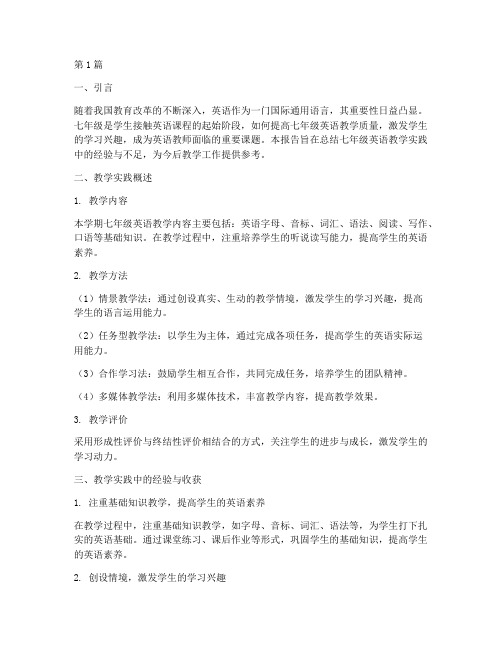
第1篇一、引言随着我国教育改革的不断深入,英语作为一门国际通用语言,其重要性日益凸显。
七年级是学生接触英语课程的起始阶段,如何提高七年级英语教学质量,激发学生的学习兴趣,成为英语教师面临的重要课题。
本报告旨在总结七年级英语教学实践中的经验与不足,为今后教学工作提供参考。
二、教学实践概述1. 教学内容本学期七年级英语教学内容主要包括:英语字母、音标、词汇、语法、阅读、写作、口语等基础知识。
在教学过程中,注重培养学生的听说读写能力,提高学生的英语素养。
2. 教学方法(1)情景教学法:通过创设真实、生动的教学情境,激发学生的学习兴趣,提高学生的语言运用能力。
(2)任务型教学法:以学生为主体,通过完成各项任务,提高学生的英语实际运用能力。
(3)合作学习法:鼓励学生相互合作,共同完成任务,培养学生的团队精神。
(4)多媒体教学法:利用多媒体技术,丰富教学内容,提高教学效果。
3. 教学评价采用形成性评价与终结性评价相结合的方式,关注学生的进步与成长,激发学生的学习动力。
三、教学实践中的经验与收获1. 注重基础知识教学,提高学生的英语素养在教学过程中,注重基础知识教学,如字母、音标、词汇、语法等,为学生打下扎实的英语基础。
通过课堂练习、课后作业等形式,巩固学生的基础知识,提高学生的英语素养。
2. 创设情境,激发学生的学习兴趣通过创设真实、生动的教学情境,激发学生的学习兴趣。
如在教授新单词时,结合图片、视频等,让学生在轻松愉快的氛围中学习。
3. 采用多样化教学方法,提高教学效果在教学过程中,根据教学内容和学生的实际情况,采用情景教学法、任务型教学法、合作学习法、多媒体教学法等多种教学方法,提高教学效果。
4. 关注学生个体差异,因材施教在教学过程中,关注学生的个体差异,根据学生的不同需求,采取不同的教学方法,使每个学生都能在课堂上有所收获。
5. 注重学生口语表达能力的培养在教学中,注重学生口语表达能力的培养,通过课堂口语练习、小组讨论、角色扮演等形式,提高学生的口语表达能力。
中学英语课堂教学理论与实践
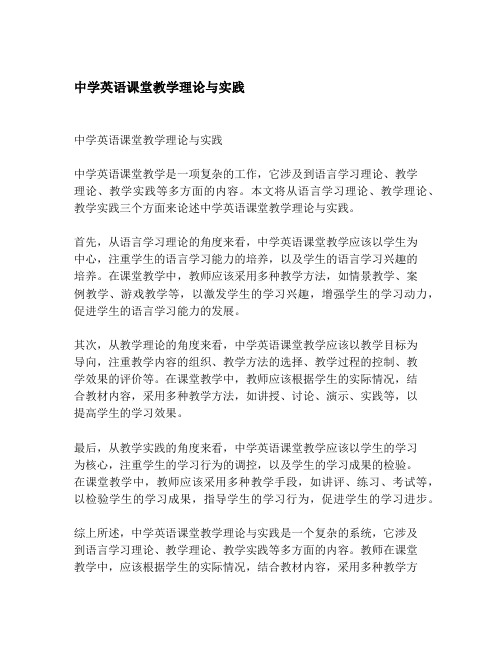
中学英语课堂教学理论与实践
中学英语课堂教学理论与实践
中学英语课堂教学是一项复杂的工作,它涉及到语言学习理论、教学
理论、教学实践等多方面的内容。
本文将从语言学习理论、教学理论、教学实践三个方面来论述中学英语课堂教学理论与实践。
首先,从语言学习理论的角度来看,中学英语课堂教学应该以学生为
中心,注重学生的语言学习能力的培养,以及学生的语言学习兴趣的
培养。
在课堂教学中,教师应该采用多种教学方法,如情景教学、案
例教学、游戏教学等,以激发学生的学习兴趣,增强学生的学习动力,促进学生的语言学习能力的发展。
其次,从教学理论的角度来看,中学英语课堂教学应该以教学目标为
导向,注重教学内容的组织、教学方法的选择、教学过程的控制、教
学效果的评价等。
在课堂教学中,教师应该根据学生的实际情况,结
合教材内容,采用多种教学方法,如讲授、讨论、演示、实践等,以
提高学生的学习效果。
最后,从教学实践的角度来看,中学英语课堂教学应该以学生的学习
为核心,注重学生的学习行为的调控,以及学生的学习成果的检验。
在课堂教学中,教师应该采用多种教学手段,如讲评、练习、考试等,以检验学生的学习成果,指导学生的学习行为,促进学生的学习进步。
综上所述,中学英语课堂教学理论与实践是一个复杂的系统,它涉及
到语言学习理论、教学理论、教学实践等多方面的内容。
教师在课堂
教学中,应该根据学生的实际情况,结合教材内容,采用多种教学方
法,如讲授、讨论、演示、实践等,以提高学生的学习效果,激发学生的学习兴趣,增强学生的学习动力,促进学生的语言学习能力的发展,检验学生的学习成果,指导学生的学习行为,促进学生的学习进步。
初中英语教学的实践活动(3篇)
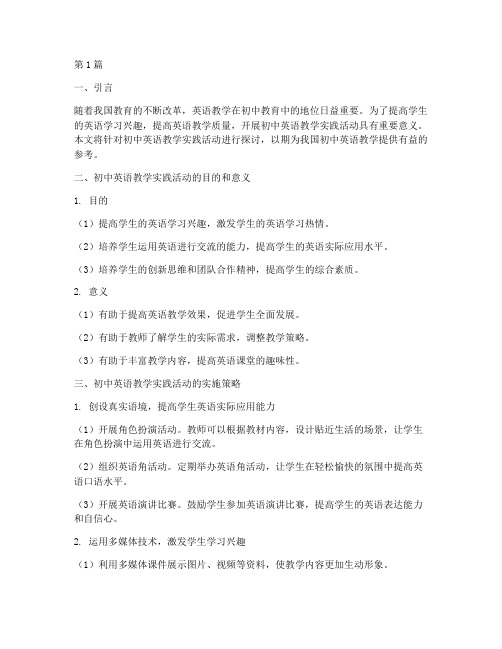
第1篇一、引言随着我国教育的不断改革,英语教学在初中教育中的地位日益重要。
为了提高学生的英语学习兴趣,提高英语教学质量,开展初中英语教学实践活动具有重要意义。
本文将针对初中英语教学实践活动进行探讨,以期为我国初中英语教学提供有益的参考。
二、初中英语教学实践活动的目的和意义1. 目的(1)提高学生的英语学习兴趣,激发学生的英语学习热情。
(2)培养学生运用英语进行交流的能力,提高学生的英语实际应用水平。
(3)培养学生的创新思维和团队合作精神,提高学生的综合素质。
2. 意义(1)有助于提高英语教学效果,促进学生全面发展。
(2)有助于教师了解学生的实际需求,调整教学策略。
(3)有助于丰富教学内容,提高英语课堂的趣味性。
三、初中英语教学实践活动的实施策略1. 创设真实语境,提高学生英语实际应用能力(1)开展角色扮演活动。
教师可以根据教材内容,设计贴近生活的场景,让学生在角色扮演中运用英语进行交流。
(2)组织英语角活动。
定期举办英语角活动,让学生在轻松愉快的氛围中提高英语口语水平。
(3)开展英语演讲比赛。
鼓励学生参加英语演讲比赛,提高学生的英语表达能力和自信心。
2. 运用多媒体技术,激发学生学习兴趣(1)利用多媒体课件展示图片、视频等资料,使教学内容更加生动形象。
(2)运用网络资源,拓展学生的知识面,提高学生的英语素养。
(3)开展线上英语学习活动,如在线英语角、英语学习社区等,让学生在互动中提高英语水平。
3. 强化听说读写训练,提高学生英语综合能力(1)听说训练。
通过听力、口语练习,提高学生的英语听力水平和口语表达能力。
(2)阅读训练。
鼓励学生多阅读英文书籍、文章,提高阅读理解能力。
(3)写作训练。
指导学生进行英语写作,提高写作水平。
4. 培养学生创新思维和团队合作精神(1)开展小组合作学习。
让学生在小组中共同完成任务,培养学生的团队合作精神。
(2)举办英语创新实践活动。
鼓励学生发挥创意,设计英语教学活动,提高学生的创新思维。
探索初中英语教育的教学新模式:理论与实践的融合
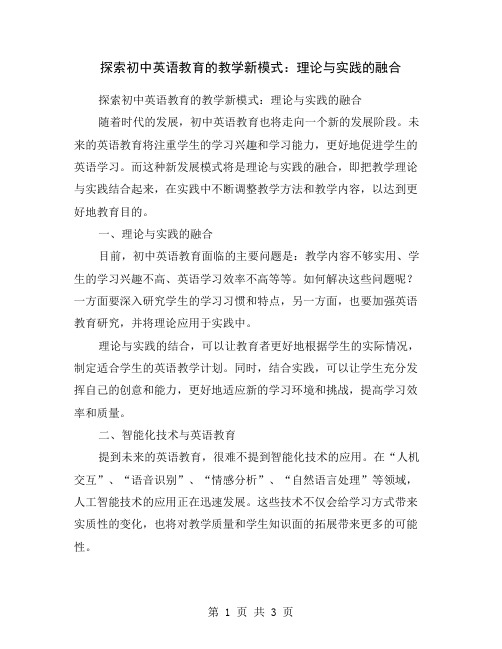
探索初中英语教育的教学新模式:理论与实践的融合探索初中英语教育的教学新模式:理论与实践的融合随着时代的发展,初中英语教育也将走向一个新的发展阶段。
未来的英语教育将注重学生的学习兴趣和学习能力,更好地促进学生的英语学习。
而这种新发展模式将是理论与实践的融合,即把教学理论与实践结合起来,在实践中不断调整教学方法和教学内容,以达到更好地教育目的。
一、理论与实践的融合目前,初中英语教育面临的主要问题是:教学内容不够实用、学生的学习兴趣不高、英语学习效率不高等等。
如何解决这些问题呢?一方面要深入研究学生的学习习惯和特点,另一方面,也要加强英语教育研究,并将理论应用于实践中。
理论与实践的结合,可以让教育者更好地根据学生的实际情况,制定适合学生的英语教学计划。
同时,结合实践,可以让学生充分发挥自己的创意和能力,更好地适应新的学习环境和挑战,提高学习效率和质量。
二、智能化技术与英语教育提到未来的英语教育,很难不提到智能化技术的应用。
在“人机交互”、“语音识别”、“情感分析”、“自然语言处理”等领域,人工智能技术的应用正在迅速发展。
这些技术不仅会给学习方式带来实质性的变化,也将对教学质量和学生知识面的拓展带来更多的可能性。
智能化技术的应用还将让学生更好地了解英语文化。
通过多媒体和实景操作,让学生亲身感受到英语文化的魅力和魔力,感知到语言与文化的紧密联系。
同时,智能化技术也会提高语言和口音的准确度,让学生更快地接近英美标准发音。
三、独立思考与创新教育英语教育需要提高学生的独立思考和创新能力。
因此,在未来英语教育中,独立思考和创新教育将是重点。
学生在学习英语的过程中,必须要能够自己思考、自己推理和自己解决问题,这样才能为将来的学习和工作打下坚实的基础。
同时,学生亦需要具备创新能力,尤其是在英语课程中。
未来英语教育要提高学生的想象力和创造力,让学生在课堂上开阔视野,进一步拓宽思路,广泛地接受认知积累,从而能够更好地运用所学,为自己的未来发展打下坚实的基础。
初中英语有效教学课堂的理论与实践
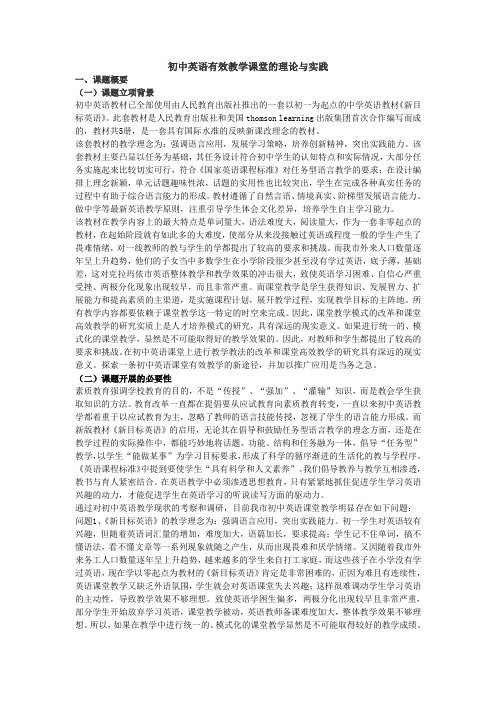
初中英语有效教学课堂的理论与实践一、课题概要(一)课题立项背景初中英语教材已全部使用由人民教育出版社推出的一套以初一为起点的中学英语教材《新目标英语》。
此套教材是人民教育出版社和美国thomson learning出版集团首次合作编写而成的,教材共5册,是一套具有国际水准的反映新课改理念的教材。
该套教材的教学理念为:强调语言应用,发展学习策略,培养创新精神,突出实践能力。
该套教材主要凸显以任务为基础,其任务设计符合初中学生的认知特点和实际情况,大部分任务实施起来比较切实可行,符合《国家英语课程标准》对任务型语言教学的要求;在设计编排上理念新颖,单元话题趣味性浓,话题的实用性也比较突出,学生在完成各种真实任务的过程中有助于综合语言能力的形成。
教材遵循了自然言语、情境真实、阶梯型发展语言能力、做中学等最新英语教学原则,注重引导学生体会文化差异,培养学生自主学习能力。
该教材在教学内容上的最大特点是单词量大,语法难度大,阅读量大,作为一套非零起点的教材,在起始阶段就有如此多的大难度,使部分从来没接触过英语或程度一般的学生产生了畏难情绪,对一线教师的教与学生的学都提出了较高的要求和挑战。
而我市外来人口数量逐年呈上升趋势,他们的子女当中多数学生在小学阶段很少甚至没有学过英语,底子薄,基础差,这对克拉玛依市英语整体教学和教学效果的冲击很大,致使英语学习困难、自信心严重受挫、两极分化现象出现较早,而且非常严重。
而课堂教学是学生获得知识、发展智力、扩展能力和提高素质的主渠道,是实施课程计划,展开教学过程,实现教学目标的主阵地。
所有教学内容都要依赖于课堂教学这一特定的时空来完成。
因此,课堂教学模式的改革和课堂高效教学的研究实质上是人才培养模式的研究,具有深远的现实意义。
如果进行统一的、模式化的课堂教学,显然是不可能取得好的教学效果的。
因此,对教师和学生都提出了较高的要求和挑战。
在初中英语课堂上进行教学教法的改革和课堂高效教学的研究具有深远的现实意义。
初中英语课堂教学实践总结
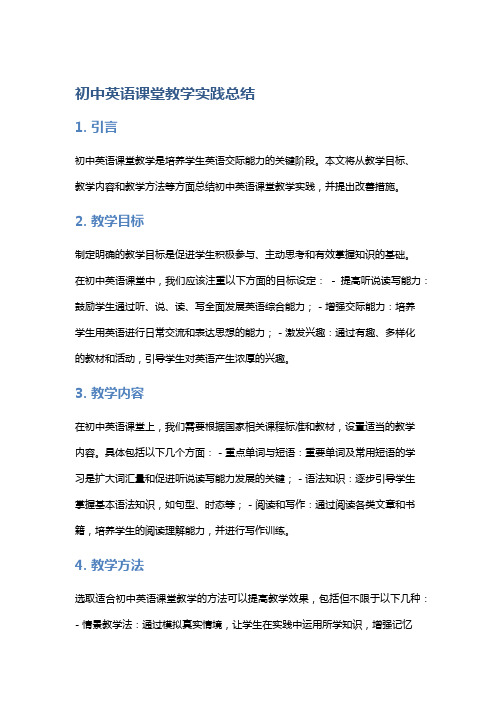
初中英语课堂教学实践总结1. 引言初中英语课堂教学是培养学生英语交际能力的关键阶段。
本文将从教学目标、教学内容和教学方法等方面总结初中英语课堂教学实践,并提出改善措施。
2. 教学目标制定明确的教学目标是促进学生积极参与、主动思考和有效掌握知识的基础。
在初中英语课堂中,我们应该注重以下方面的目标设定:- 提高听说读写能力:鼓励学生通过听、说、读、写全面发展英语综合能力; - 增强交际能力:培养学生用英语进行日常交流和表达思想的能力; - 激发兴趣:通过有趣、多样化的教材和活动,引导学生对英语产生浓厚的兴趣。
3. 教学内容在初中英语课堂上,我们需要根据国家相关课程标准和教材,设置适当的教学内容。
具体包括以下几个方面: - 重点单词与短语:重要单词及常用短语的学习是扩大词汇量和促进听说读写能力发展的关键; - 语法知识:逐步引导学生掌握基本语法知识,如句型、时态等; - 阅读和写作:通过阅读各类文章和书籍,培养学生的阅读理解能力,并进行写作训练。
4. 教学方法选取适合初中英语课堂教学的方法可以提高教学效果,包括但不限于以下几种:- 情景教学法:通过模拟真实情境,让学生在实践中运用所学知识,增强记忆和应用能力; - 合作学习法:组织小组活动,促进同学间互相协作、交流,共同完成任务; - 多媒体辅助教学:利用现代化技术手段如PPT、音频、视频等工具,激发兴趣并提高教学效果。
5. 教学评价与改善为了评估教学质量和改善教育效果,在初中英语课堂上需要进行有效的评价。
可以采取以下方式: - 进行日常测验或小考:定期进行简单的测验,检查学生对所学知识的掌握程度; - 作业评价:仔细批改学生的写作和阅读作业,给予针对性建议和肯定; - 学习档案管理:建立详细的学生档案,记录每个学生的成绩、表现等信息。
6. 总结与展望初中英语课堂教学实践是一个不断总结经验、探索创新的过程。
通过合理设定教学目标、选择适宜教学内容和方法,并利用评价机制进行调整,我们可以提高教学质量,促进学生英语能力全面发展。
初中英语课程教学实践(3篇)
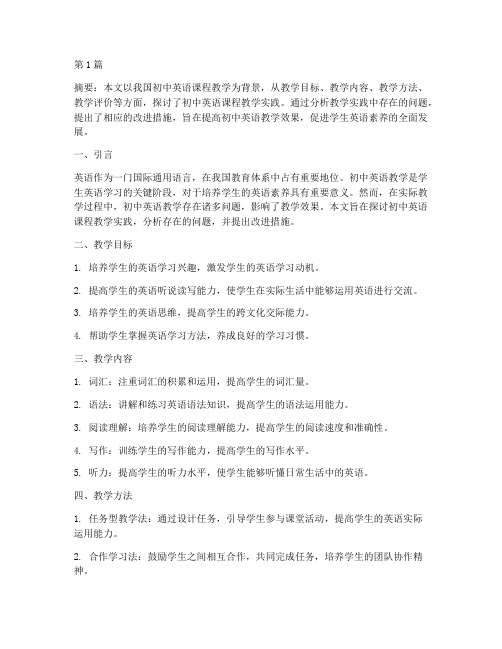
第1篇摘要:本文以我国初中英语课程教学为背景,从教学目标、教学内容、教学方法、教学评价等方面,探讨了初中英语课程教学实践。
通过分析教学实践中存在的问题,提出了相应的改进措施,旨在提高初中英语教学效果,促进学生英语素养的全面发展。
一、引言英语作为一门国际通用语言,在我国教育体系中占有重要地位。
初中英语教学是学生英语学习的关键阶段,对于培养学生的英语素养具有重要意义。
然而,在实际教学过程中,初中英语教学存在诸多问题,影响了教学效果。
本文旨在探讨初中英语课程教学实践,分析存在的问题,并提出改进措施。
二、教学目标1. 培养学生的英语学习兴趣,激发学生的英语学习动机。
2. 提高学生的英语听说读写能力,使学生在实际生活中能够运用英语进行交流。
3. 培养学生的英语思维,提高学生的跨文化交际能力。
4. 帮助学生掌握英语学习方法,养成良好的学习习惯。
三、教学内容1. 词汇:注重词汇的积累和运用,提高学生的词汇量。
2. 语法:讲解和练习英语语法知识,提高学生的语法运用能力。
3. 阅读理解:培养学生的阅读理解能力,提高学生的阅读速度和准确性。
4. 写作:训练学生的写作能力,提高学生的写作水平。
5. 听力:提高学生的听力水平,使学生能够听懂日常生活中的英语。
四、教学方法1. 任务型教学法:通过设计任务,引导学生参与课堂活动,提高学生的英语实际运用能力。
2. 合作学习法:鼓励学生之间相互合作,共同完成任务,培养学生的团队协作精神。
3. 情境教学法:创设真实情境,让学生在情境中学习英语,提高学生的英语交际能力。
4. 多媒体教学法:运用多媒体技术,丰富教学内容,提高学生的学习兴趣。
5. 互动式教学法:通过师生互动、生生互动,激发学生的学习积极性,提高教学效果。
五、教学评价1. 过程性评价:关注学生在课堂上的表现,如参与度、合作度、完成任务的情况等。
2. 终结性评价:通过考试、作业等形式,评价学生的英语学习成果。
3. 形成性评价:关注学生的英语学习态度、学习方法、学习习惯等方面。
中学英语教学创新实践(3篇)
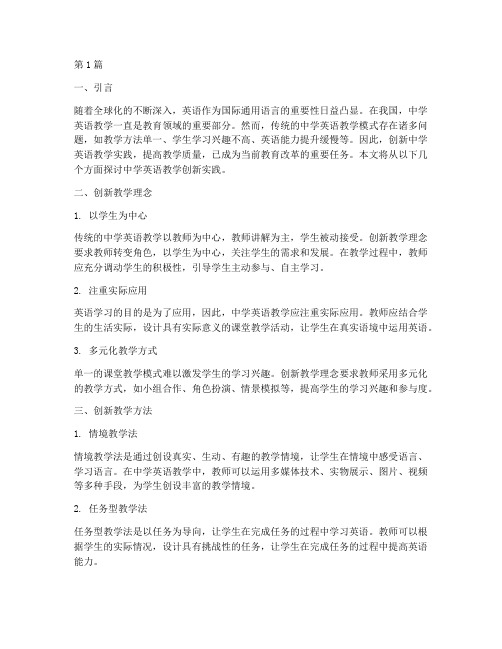
第1篇一、引言随着全球化的不断深入,英语作为国际通用语言的重要性日益凸显。
在我国,中学英语教学一直是教育领域的重要部分。
然而,传统的中学英语教学模式存在诸多问题,如教学方法单一、学生学习兴趣不高、英语能力提升缓慢等。
因此,创新中学英语教学实践,提高教学质量,已成为当前教育改革的重要任务。
本文将从以下几个方面探讨中学英语教学创新实践。
二、创新教学理念1. 以学生为中心传统的中学英语教学以教师为中心,教师讲解为主,学生被动接受。
创新教学理念要求教师转变角色,以学生为中心,关注学生的需求和发展。
在教学过程中,教师应充分调动学生的积极性,引导学生主动参与、自主学习。
2. 注重实际应用英语学习的目的是为了应用,因此,中学英语教学应注重实际应用。
教师应结合学生的生活实际,设计具有实际意义的课堂教学活动,让学生在真实语境中运用英语。
3. 多元化教学方式单一的课堂教学模式难以激发学生的学习兴趣。
创新教学理念要求教师采用多元化的教学方式,如小组合作、角色扮演、情景模拟等,提高学生的学习兴趣和参与度。
三、创新教学方法1. 情境教学法情境教学法是通过创设真实、生动、有趣的教学情境,让学生在情境中感受语言、学习语言。
在中学英语教学中,教师可以运用多媒体技术、实物展示、图片、视频等多种手段,为学生创设丰富的教学情境。
2. 任务型教学法任务型教学法是以任务为导向,让学生在完成任务的过程中学习英语。
教师可以根据学生的实际情况,设计具有挑战性的任务,让学生在完成任务的过程中提高英语能力。
3. 合作学习法合作学习法强调学生在小组中共同学习、共同进步。
教师可以将学生分成若干小组,让小组成员在讨论、交流、合作中完成学习任务,提高学生的英语交际能力。
四、创新教学评价1. 过程性评价传统的教学评价过于注重结果,忽视学生的学习过程。
创新教学评价应注重过程性评价,关注学生在学习过程中的表现,如参与度、合作精神、自主学习能力等。
2. 多元化评价传统的教学评价方式单一,难以全面反映学生的学习成果。
教学实践初中英语(3篇)
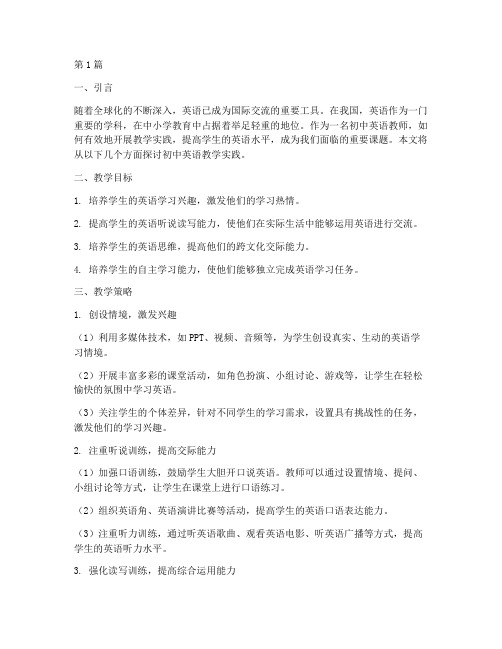
第1篇一、引言随着全球化的不断深入,英语已成为国际交流的重要工具。
在我国,英语作为一门重要的学科,在中小学教育中占据着举足轻重的地位。
作为一名初中英语教师,如何有效地开展教学实践,提高学生的英语水平,成为我们面临的重要课题。
本文将从以下几个方面探讨初中英语教学实践。
二、教学目标1. 培养学生的英语学习兴趣,激发他们的学习热情。
2. 提高学生的英语听说读写能力,使他们在实际生活中能够运用英语进行交流。
3. 培养学生的英语思维,提高他们的跨文化交际能力。
4. 培养学生的自主学习能力,使他们能够独立完成英语学习任务。
三、教学策略1. 创设情境,激发兴趣(1)利用多媒体技术,如PPT、视频、音频等,为学生创设真实、生动的英语学习情境。
(2)开展丰富多彩的课堂活动,如角色扮演、小组讨论、游戏等,让学生在轻松愉快的氛围中学习英语。
(3)关注学生的个体差异,针对不同学生的学习需求,设置具有挑战性的任务,激发他们的学习兴趣。
2. 注重听说训练,提高交际能力(1)加强口语训练,鼓励学生大胆开口说英语。
教师可以通过设置情境、提问、小组讨论等方式,让学生在课堂上进行口语练习。
(2)组织英语角、英语演讲比赛等活动,提高学生的英语口语表达能力。
(3)注重听力训练,通过听英语歌曲、观看英语电影、听英语广播等方式,提高学生的英语听力水平。
3. 强化读写训练,提高综合运用能力(1)引导学生进行阅读,培养他们的阅读兴趣。
教师可以推荐适合初中生的英语读物,让学生在阅读中提高英语水平。
(2)加强写作训练,指导学生掌握英语写作技巧。
教师可以通过批改作业、课堂讲解、示范等方式,帮助学生提高写作水平。
(3)开展英语写作比赛,激发学生的写作兴趣,提高他们的写作能力。
4. 培养自主学习能力,提高学习效率(1)指导学生制定学习计划,培养他们的自主学习意识。
(2)鼓励学生利用网络资源,如英语学习网站、APP等,进行自主学习和拓展。
(3)开展课外英语活动,如英语角、英语俱乐部等,让学生在课外时间提高英语水平。
初中英语教学实践(3篇)
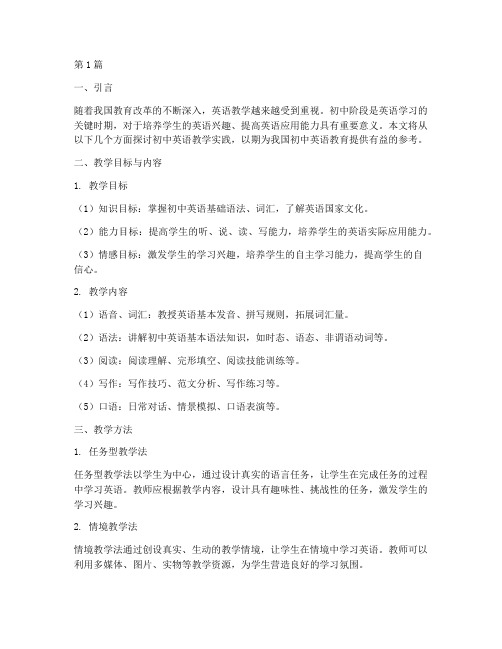
第1篇一、引言随着我国教育改革的不断深入,英语教学越来越受到重视。
初中阶段是英语学习的关键时期,对于培养学生的英语兴趣、提高英语应用能力具有重要意义。
本文将从以下几个方面探讨初中英语教学实践,以期为我国初中英语教育提供有益的参考。
二、教学目标与内容1. 教学目标(1)知识目标:掌握初中英语基础语法、词汇,了解英语国家文化。
(2)能力目标:提高学生的听、说、读、写能力,培养学生的英语实际应用能力。
(3)情感目标:激发学生的学习兴趣,培养学生的自主学习能力,提高学生的自信心。
2. 教学内容(1)语音、词汇:教授英语基本发音、拼写规则,拓展词汇量。
(2)语法:讲解初中英语基本语法知识,如时态、语态、非谓语动词等。
(3)阅读:阅读理解、完形填空、阅读技能训练等。
(4)写作:写作技巧、范文分析、写作练习等。
(5)口语:日常对话、情景模拟、口语表演等。
三、教学方法1. 任务型教学法任务型教学法以学生为中心,通过设计真实的语言任务,让学生在完成任务的过程中学习英语。
教师应根据教学内容,设计具有趣味性、挑战性的任务,激发学生的学习兴趣。
2. 情境教学法情境教学法通过创设真实、生动的教学情境,让学生在情境中学习英语。
教师可以利用多媒体、图片、实物等教学资源,为学生营造良好的学习氛围。
3. 合作学习法合作学习法强调学生在学习过程中相互合作、相互帮助。
教师可以将学生分成小组,让他们在小组内进行讨论、交流,共同完成任务。
4. 情感教学法情感教学法关注学生的情感需求,通过激发学生的学习兴趣,提高学生的自信心。
教师应关注学生的心理变化,及时调整教学策略。
四、教学实践1. 课前准备(1)教师应熟悉教学内容,掌握教学目标。
(2)制作教学课件,准备教学资源。
(3)设计教学任务,制定教学计划。
2. 课堂教学(1)导入:通过歌曲、游戏、图片等手段,激发学生的学习兴趣。
(2)新课教授:讲解知识点,引导学生掌握英语技能。
(3)任务实施:组织学生完成任务,观察学生的学习情况。
初中英语教学实践总结(3篇)

第1篇一、引言随着我国教育事业的发展,英语教学在初中阶段日益受到重视。
作为一名初中英语教师,我深知自身肩负的责任和使命。
在过去的教学实践中,我不断探索、总结,努力提高自己的教育教学水平。
本文将对我初中英语教学实践进行总结,以期对今后的教学工作有所帮助。
二、教学理念1.以人为本:关注学生的个体差异,尊重学生的兴趣和需求,激发学生的学习热情。
2.全面发展:注重学生的语言能力、思维能力、文化素养等各方面的发展。
3.实践导向:强调学生在真实语境中运用英语,提高英语实际运用能力。
4.合作探究:鼓励学生积极参与课堂活动,培养合作精神和探究能力。
三、教学方法1.情景教学法:创设真实、有趣的情景,让学生在情景中学习英语。
2.任务型教学法:设计有意义的任务,让学生在完成任务的过程中学习英语。
3.合作学习法:分组进行讨论、交流,提高学生的合作意识和团队精神。
4.多媒体教学法:运用多媒体技术,丰富教学内容,提高教学效果。
四、教学实践1.课堂管理(1)建立良好的课堂纪律,营造和谐、轻松的课堂氛围。
(2)关注学生的个体差异,给予不同层次的学生适当的关注和指导。
(3)培养学生的自主学习能力,让学生在课堂上有更多自主学习的空间。
2.教学内容(1)注重基础知识的教学,提高学生的英语基础水平。
(2)关注学生的英语实际运用能力,加强听说读写技能的培养。
(3)拓展学生的文化视野,让学生了解西方文化,提高跨文化交际能力。
3.教学活动(1)开展丰富多彩的课堂活动,激发学生的学习兴趣。
(2)组织学生参加英语角、英语演讲比赛等活动,提高学生的英语实际运用能力。
(3)开展英语角、英语沙龙等活动,促进学生之间的交流与合作。
五、教学反思1.加强自身专业素养,提高教育教学水平。
2.关注学生的个体差异,因材施教。
3.注重培养学生的英语实际运用能力,提高学生的综合素质。
4.创新教学方法,提高教学效果。
六、结语总之,初中英语教学是一项充满挑战和机遇的工作。
浅析初中英语课堂理论与实践的结合教学
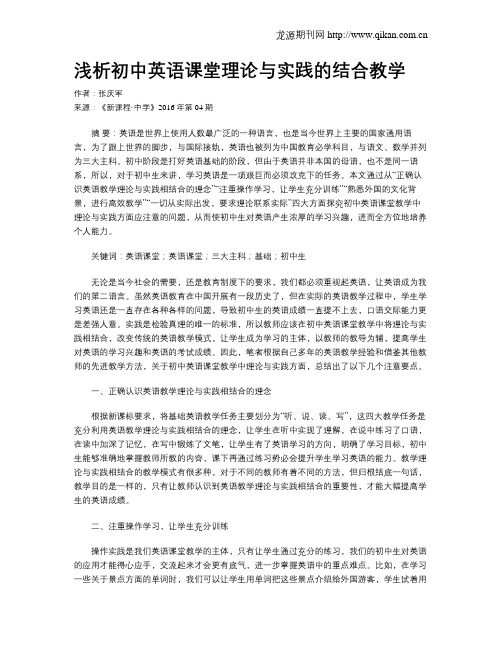
浅析初中英语课堂理论与实践的结合教学作者:张庆军来源:《新课程·中学》2016年第04期摘要:英语是世界上使用人数最广泛的一种语言,也是当今世界上主要的国家通用语言,为了跟上世界的脚步,与国际接轨,英语也被列为中国教育必学科目,与语文、数学并列为三大主科。
初中阶段是打好英语基础的阶段,但由于英语并非本国的母语,也不是同一语系,所以,对于初中生来讲,学习英语是一项艰巨而必须攻克下的任务。
本文通过从“正确认识英语教学理论与实践相结合的理念”“注重操作学习,让学生充分训练”“熟悉外国的文化背景,进行高效教学”“一切从实际出发,要求理论联系实际”四大方面探究初中英语课堂教学中理论与实践方面应注意的问题,从而使初中生对英语产生浓厚的学习兴趣,进而全方位地培养个人能力。
关键词:英语课堂;英语课堂;三大主科;基础;初中生无论是当今社会的需要,还是教育制度下的要求,我们都必须重视起英语,让英语成为我们的第二语言。
虽然英语教育在中国开展有一段历史了,但在实际的英语教学过程中,学生学习英语还是一直存在各种各样的问题,导致初中生的英语成绩一直提不上去,口语交际能力更是差强人意。
实践是检验真理的唯一的标准,所以教师应该在初中英语课堂教学中将理论与实践相结合,改变传统的英语教学模式,让学生成为学习的主体,以教师的教导为辅,提高学生对英语的学习兴趣和英语的考试成绩。
因此,笔者根据自己多年的英语教学经验和借鉴其他教师的先进教学方法,关于初中英语课堂教学中理论与实践方面,总结出了以下几个注意要点。
一、正确认识英语教学理论与实践相结合的理念根据新课标要求,将基础英语教学任务主要划分为“听、说、读、写”,这四大教学任务是充分利用英语教学理论与实践相结合的理念,让学生在听中实现了理解,在说中练习了口语,在读中加深了记忆,在写中锻炼了文笔,让学生有了英语学习的方向,明确了学习目标,初中生能够准确地掌握教师所教的内容,课下再通过练习势必会提升学生学习英语的能力。
初中英语教学工作实践(3篇)
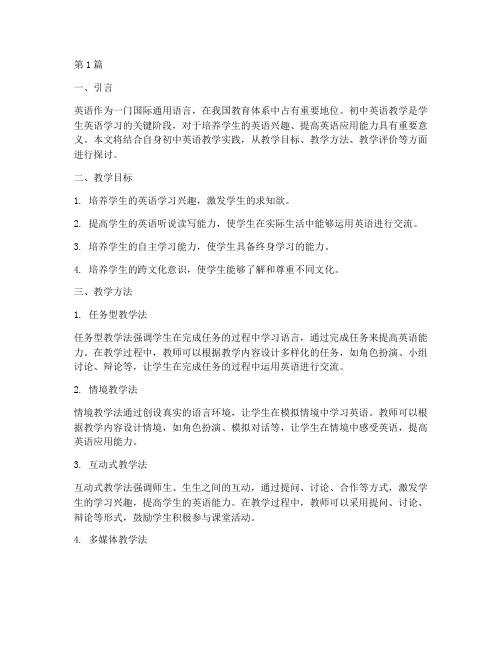
第1篇一、引言英语作为一门国际通用语言,在我国教育体系中占有重要地位。
初中英语教学是学生英语学习的关键阶段,对于培养学生的英语兴趣、提高英语应用能力具有重要意义。
本文将结合自身初中英语教学实践,从教学目标、教学方法、教学评价等方面进行探讨。
二、教学目标1. 培养学生的英语学习兴趣,激发学生的求知欲。
2. 提高学生的英语听说读写能力,使学生在实际生活中能够运用英语进行交流。
3. 培养学生的自主学习能力,使学生具备终身学习的能力。
4. 培养学生的跨文化意识,使学生能够了解和尊重不同文化。
三、教学方法1. 任务型教学法任务型教学法强调学生在完成任务的过程中学习语言,通过完成任务来提高英语能力。
在教学过程中,教师可以根据教学内容设计多样化的任务,如角色扮演、小组讨论、辩论等,让学生在完成任务的过程中运用英语进行交流。
2. 情境教学法情境教学法通过创设真实的语言环境,让学生在模拟情境中学习英语。
教师可以根据教学内容设计情境,如角色扮演、模拟对话等,让学生在情境中感受英语,提高英语应用能力。
3. 互动式教学法互动式教学法强调师生、生生之间的互动,通过提问、讨论、合作等方式,激发学生的学习兴趣,提高学生的英语能力。
在教学过程中,教师可以采用提问、讨论、辩论等形式,鼓励学生积极参与课堂活动。
4. 多媒体教学法多媒体教学法利用多媒体技术,将声音、图像、文字等多种信息传递给学生,提高学生的学习兴趣。
教师可以利用多媒体播放英语歌曲、电影片段等,让学生在欣赏中学习英语。
四、教学评价1. 形成性评价形成性评价关注学生在学习过程中的表现,如课堂参与度、作业完成情况等。
教师可以通过观察、访谈、问卷调查等方式,了解学生的学习情况,及时调整教学策略。
2. 总结性评价总结性评价关注学生在一段时间内的学习成果,如考试成绩、英语能力测试等。
教师可以根据学生的考试成绩和英语能力测试结果,对学生的学习情况进行总结和评价。
3. 学生自评与互评学生自评与互评是提高学生自我反思能力的重要手段。
英语教学理论及实践报告(3篇)
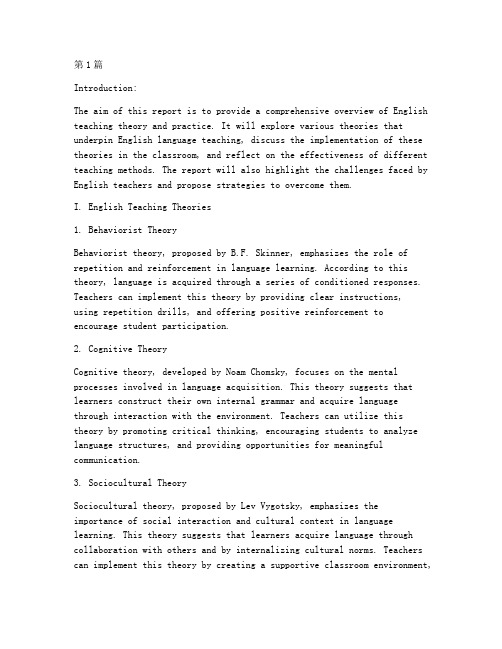
第1篇Introduction:The aim of this report is to provide a comprehensive overview of English teaching theory and practice. It will explore various theories that underpin English language teaching, discuss the implementation of these theories in the classroom, and reflect on the effectiveness of different teaching methods. The report will also highlight the challenges faced by English teachers and propose strategies to overcome them.I. English Teaching Theories1. Behaviorist TheoryBehaviorist theory, proposed by B.F. Skinner, emphasizes the role of repetition and reinforcement in language learning. According to this theory, language is acquired through a series of conditioned responses. Teachers can implement this theory by providing clear instructions,using repetition drills, and offering positive reinforcement to encourage student participation.2. Cognitive TheoryCognitive theory, developed by Noam Chomsky, focuses on the mental processes involved in language acquisition. This theory suggests that learners construct their own internal grammar and acquire language through interaction with the environment. Teachers can utilize this theory by promoting critical thinking, encouraging students to analyze language structures, and providing opportunities for meaningful communication.3. Sociocultural TheorySociocultural theory, proposed by Lev Vygotsky, emphasizes the importance of social interaction and cultural context in language learning. This theory suggests that learners acquire language through collaboration with others and by internalizing cultural norms. Teachers can implement this theory by creating a supportive classroom environment,encouraging group work, and integrating cultural activities into the curriculum.4. Humanistic TheoryHumanistic theory, developed by Carl Rogers, emphasizes the importanceof the individual's personal growth and self-actualization in language learning. This theory suggests that learners are motivated by intrinsic factors and that teachers should focus on creating a positive,supportive classroom atmosphere. Teachers can implement this theory by encouraging student autonomy, promoting self-reflection, and valuing student feedback.II. Implementation of English Teaching Theories in the Classroom1. Behaviorist ApproachIn a behaviorist classroom, teachers can use techniques such as direct instruction, repetition drills, and positive reinforcement to facilitate language learning. For example, teachers can use a grammar workbook to introduce new structures, followed by controlled practice and corrective feedback to ensure students internalize the language.2. Cognitive ApproachA cognitive classroom encourages students to actively engage with the language, analyze its structures, and make connections with theirexisting knowledge. Teachers can use activities such as vocabulary games, reading comprehension exercises, and writing prompts to promote critical thinking and language development.3. Sociocultural ApproachIn a sociocultural classroom, teachers can foster collaboration and cultural awareness through activities such as group projects, cultural exchange programs, and language games. By encouraging students tointeract with peers from different backgrounds, teachers can promote language acquisition and cultural understanding.4. Humanistic ApproachA humanistic classroom focuses on creating a supportive environment that allows students to explore their own identities and express themselves. Teachers can use techniques such as open-ended discussions, reflection activities, and peer assessment to promote student autonomy and self-awareness.III. Challenges and Strategies1. Language BarriersOne of the primary challenges in English language teaching is overcoming language barriers. To address this, teachers can use simple language, visual aids, and gestures to convey their messages effectively. Additionally, providing opportunities for students to practice their speaking and listening skills in a supportive environment can help bridge the language gap.2. Diverse Learning StylesStudents have varying learning styles, which can make it challenging to cater to all learners. To overcome this, teachers can use a variety of teaching methods, such as visual, auditory, and kinesthetic approaches, to engage different types of learners. By incorporating activities that cater to diverse learning styles, teachers can create a more inclusive classroom environment.3. MotivationMaintaining student motivation can be challenging, especially in a language learning context. To address this, teachers can create engaging and relevant lessons, incorporate real-life contexts, and offer opportunities for student choice and autonomy. By making the learning process enjoyable and meaningful, teachers can foster a positiveattitude towards language learning.Conclusion:This report has provided an overview of English teaching theory and practice, highlighting the importance of understanding different theories and their application in the classroom. By incorporatingvarious teaching methods and addressing the challenges faced by English teachers, educators can create an effective and engaging learning environment that promotes language acquisition and personal growth.第2篇IntroductionEnglish language teaching (ELT) has evolved significantly over the years, with various theories and practices shaping the way educators approach the classroom. This report aims to provide a comprehensive overview of key ELT theories and their practical application in the classroom. By examining these theories and practices, we can gain insights into how to create effective and engaging learning environments for English language learners (ELLs).1. Theoretical Frameworks in English Language Teaching1.1 BehaviorismBehaviorism, founded by B.F. Skinner, suggests that learning is a result of behavior modification through reinforcement and punishment. In the context of ELT, behaviorist approaches focus on creating controlled environments where students can practice and perfect their languageskills through repetition and positive reinforcement.1.2 Cognitive DevelopmentCognitive development theory, proposed by Jean Piaget, emphasizes the importance of learners' mental processes in language acquisition. This theory highlights the stages of cognitive development that learners go through, and suggests that teachers should adapt their teaching methods to cater to these stages.1.3 Communicative Language Teaching (CLT)Communicative Language Teaching (CLT) is an approach that focuses on communication as the primary goal of language learning. This theory emphasizes the importance of real-life communication tasks, interaction, and the development of fluency and accuracy. Teachers using CLT oftenemploy techniques such as role-plays, discussions, and group work to promote communication skills.1.4 Task-Based Language Teaching (TBLT)Task-Based Language Teaching (TBLT) is a method that organizes language learning around tasks that learners are likely to encounter in real-life situations. This approach emphasizes the importance of task completion and focuses on the meaning of language rather than just the form. Teachers using TBLT design tasks that require students to use the language in context.1.5 Sociocultural TheorySociocultural theory, proposed by Lev Vygotsky, suggests that learning is a social process that occurs through interaction with others. This theory emphasizes the importance of the cultural context in which learning takes place and the role of the teacher as a facilitator of learning.2. Practical Application of Theories in the Classroom2.1 Behaviorist ApproachIn a behaviorist classroom, teachers can use techniques such as the following:- Direct instruction: Presenting new language structures and vocabulary through explicit teaching.- Drilling: Repeating exercises and activities to reinforce language patterns and structures.- Positive reinforcement: Providing praise and rewards for correct responses and progress.2.2 Cognitive Development ApproachTo apply cognitive development theory in the classroom, teachers can:- Adjust teaching methods to cater to different stages of cognitive development.- Use scaffolding techniques to guide learners through complex tasks.- Provide opportunities for learners to engage in problem-solving activities.2.3 Communicative Language Teaching (CLT)Implementing CLT in the classroom involves:- Designing activities that promote interaction and communication.- Encouraging learners to use the target language in real-life contexts.- Providing opportunities for learners to practice speaking, listening, reading, and writing skills.2.4 Task-Based Language Teaching (TBLT)Incorporating TBLT into the classroom can be achieved through:- Designing tasks that are meaningful and relevant to learners' lives.- Ensuring that tasks require learners to use the target language in context.- Providing feedback and assessment based on task completion and language use.2.5 Sociocultural TheoryApplying sociocultural theory in the classroom includes:- Creating a supportive and collaborative learning environment.- Encouraging learners to interact with peers and share their cultural perspectives.- Facilitating the development of learners' metacognitive skills through guided instruction.3. ConclusionThis report has explored various ELT theories and their practical application in the classroom. By understanding these theories andimplementing their corresponding practices, teachers can createeffective and engaging learning environments for their students. As language learning continues to evolve, it is crucial for educators to stay informed about new theories and methods to ensure that their teaching practices remain relevant and effective.第3篇IntroductionThis report aims to provide an in-depth analysis of English teaching theory and its practical application in the classroom. It explores various theoretical frameworks that guide English language teaching, discusses their implications for classroom practice, and presents a case study of a teaching intervention that integrates these theories.Theoretical Frameworks in English Language Teaching1. Theoretical Approaches to Language Learninga. Behaviorism: This approach, rooted in B.F. Skinner's work, suggests that language is a system of stimulus-response relationships. Teachers can use this theory to design activities that reinforce correct language use.b. Cognitive Approach: Proposed by scholars like Krashen, this approach emphasizes the role of mental processes in language learning.It suggests that learners construct their knowledge of language through interaction and meaningful communication.c. Sociocultural Approach: Based on the work of Vygotsky, this theory highlights the importance of social interaction and cultural context in language learning. It suggests that language is a tool for social interaction and cognitive development.2. Theories of Language Teachinga. The Direct Method: This method, popularized by the oralists, emphasizes the use of the target language in the classroom. It focuseson conversational practice and the development of pronunciation and intonation.b. The Audio-Lingual Method: Also known as the Structural Approach, this method focuses on the systematic presentation and practice of grammatical structures. It uses repetition and rote learning tofacilitate language acquisition.c. The Communicative Approach: This approach, developed in the 1970s, emphasizes communication and interaction as the primary goals of language learning. It encourages teachers to design activities that promote meaningful and purposeful communication.3. Curriculum Development and Assessmenta. Curriculum Development: The curriculum should be designed to meet the needs and interests of learners, as well as the goals of the educational institution. It should incorporate a variety of teaching and learning activities, resources, and assessment methods.b. Assessment: Assessment should be used to evaluate learners' progress and inform teaching decisions. It should be formative, as well as summative, and should include both quantitative and qualitative measures.Practical Application in the ClassroomThe following case study illustrates how a teacher can integrate various theoretical frameworks into classroom practice.Case Study: Integrating Theoretical Frameworks into Classroom PracticeTeacher: Ms. JohnsonGrade Level: 8th GradeSubject: English Language ArtsContext: Ms. Johnson teaches an 8th-grade English class at a public school in a suburban area. The students come from diverse cultural backgrounds and have varying levels of English proficiency.Teaching Intervention1. Behaviorism: Ms. Johnson uses positive reinforcement to encourage students to participate in class discussions. She rewards students who volunteer to answer questions or share their thoughts with stickers or verbal praise.2. Cognitive Approach: To develop students' critical thinking skills, Ms. Johnson designs activities that require students to analyze and evaluate texts. For example, she asks students to compare and contrast characters in a novel and explain their similarities and differences.3. Sociocultural Approach: Ms. Johnson incorporates cultural activities into her lessons to promote understanding and appreciation of diverse cultures. For instance, she organizes a cultural fair where students showcase their heritage and share stories about their families.4. Direct Method: Ms. Johnson uses the target language extensively inher lessons. She encourages students to speak English during class discussions and provides opportunities for them to practice their listening and speaking skills.5. Communicative Approach: Ms. Johnson designs activities that promote meaningful communication. For example, she organizes group projects where students work together to create a presentation on a given topic.AssessmentMs. Johnson uses a variety of assessment methods to evaluate herstudents' progress. These include:- Quizzes and tests to measure students' knowledge of grammar and vocabulary.- Oral presentations to assess students' speaking and listening skills.- Writing assignments to evaluate students' writing abilities.- Portfolios to track students' progress over time.ConclusionThis report has explored various theoretical frameworks in English language teaching and their practical application in the classroom. By integrating these theories into their teaching practice, teachers can create a more engaging and effective learning environment for their students. The case study presented demonstrates how a teacher can successfully implement these theories to enhance students' language learning experiences.。
初中英语教案的教育理论
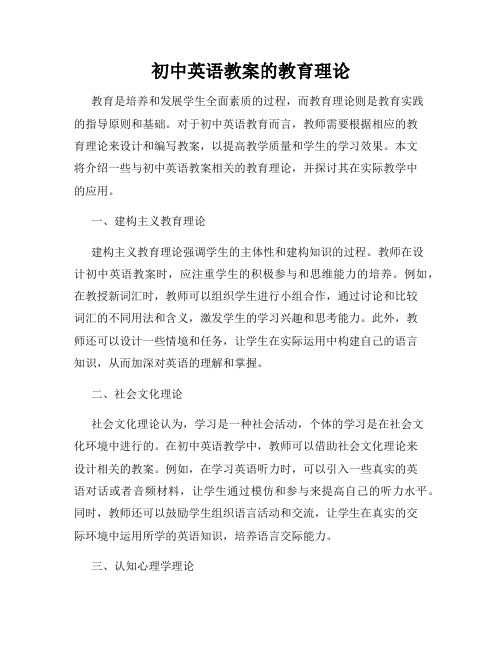
初中英语教案的教育理论教育是培养和发展学生全面素质的过程,而教育理论则是教育实践的指导原则和基础。
对于初中英语教育而言,教师需要根据相应的教育理论来设计和编写教案,以提高教学质量和学生的学习效果。
本文将介绍一些与初中英语教案相关的教育理论,并探讨其在实际教学中的应用。
一、建构主义教育理论建构主义教育理论强调学生的主体性和建构知识的过程。
教师在设计初中英语教案时,应注重学生的积极参与和思维能力的培养。
例如,在教授新词汇时,教师可以组织学生进行小组合作,通过讨论和比较词汇的不同用法和含义,激发学生的学习兴趣和思考能力。
此外,教师还可以设计一些情境和任务,让学生在实际运用中构建自己的语言知识,从而加深对英语的理解和掌握。
二、社会文化理论社会文化理论认为,学习是一种社会活动,个体的学习是在社会文化环境中进行的。
在初中英语教学中,教师可以借助社会文化理论来设计相关的教案。
例如,在学习英语听力时,可以引入一些真实的英语对话或者音频材料,让学生通过模仿和参与来提高自己的听力水平。
同时,教师还可以鼓励学生组织语言活动和交流,让学生在真实的交际环境中运用所学的英语知识,培养语言交际能力。
三、认知心理学理论认知心理学理论关注学习的认知过程和心理机制。
在初中英语教学中,教师可以根据认知心理学理论来设计教案,提高学生的学习效果。
例如,在教学语法知识时,教师可以通过提供具体的例子和图示,帮助学生理解和记忆语法规则。
此外,教师还可以设计一些思维导图或者课堂游戏,激发学生的思考和创造力,提高他们的学习兴趣和积极性。
四、个别差异理论个别差异理论认为每个学生都有其独特的学习差异和潜力。
在初中英语教学中,教师应根据学生的差异性来设计教案,满足不同学生的学习需求。
例如,在复习和巩固知识点时,教师可以提供一些不同难度的练习,让学生根据自己的水平选择适合自己的练习内容。
同时,教师可以采用多样化的教学方法和策略,以帮助弱势学生提高学习成绩,激励优秀学生更上一层楼。
英语教学理论及实践(3篇)
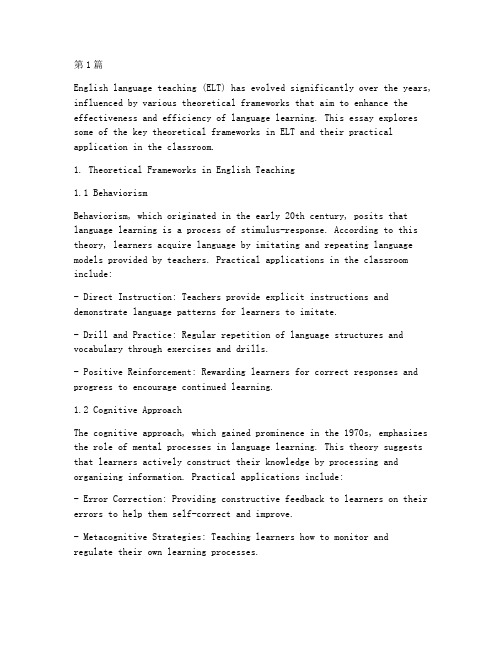
第1篇English language teaching (ELT) has evolved significantly over the years, influenced by various theoretical frameworks that aim to enhance the effectiveness and efficiency of language learning. This essay explores some of the key theoretical frameworks in ELT and their practical application in the classroom.1. Theoretical Frameworks in English Teaching1.1 BehaviorismBehaviorism, which originated in the early 20th century, posits that language learning is a process of stimulus-response. According to this theory, learners acquire language by imitating and repeating language models provided by teachers. Practical applications in the classroom include:- Direct Instruction: Teachers provide explicit instructions and demonstrate language patterns for learners to imitate.- Drill and Practice: Regular repetition of language structures and vocabulary through exercises and drills.- Positive Reinforcement: Rewarding learners for correct responses and progress to encourage continued learning.1.2 Cognitive ApproachThe cognitive approach, which gained prominence in the 1970s, emphasizes the role of mental processes in language learning. This theory suggests that learners actively construct their knowledge by processing and organizing information. Practical applications include:- Error Correction: Providing constructive feedback to learners on their errors to help them self-correct and improve.- Metacognitive Strategies: Teaching learners how to monitor andregulate their own learning processes.- Task-Based Language Learning: Engaging learners in real-life tasksthat require them to use the language in context.1.3 Communicative ApproachThe communicative approach, which emerged in the late 1970s, focuses on the communicative function of language. This theory argues that language learning should be centered around communication, with learners actively participating in language use. Practical applications include:- Role-Playing: Encouraging learners to engage in simulated conversations to practice language in real-life contexts.- Project-Based Learning: Assigning projects that require learners to use English to research, plan, and present information.- Pair and Group Work: Promoting interaction and collaboration among learners to enhance language skills.1.4 Sociocultural ApproachThe sociocultural approach, which is influenced by the work of Lev Vygotsky, emphasizes the role of social interaction and cultural context in language learning. This theory suggests that learners develop language skills through social interaction and cultural immersion. Practical applications include:- Cultural Exchange Activities: Organizing activities that allow learners to learn about and appreciate different cultures.- Language Immersion: Providing opportunities for learners to use English in authentic settings, such as language exchanges or study abroad programs.- Collaborative Learning: Encouraging learners to work together on tasks to develop language skills and cultural understanding.2. Practical Application of Theoretical Frameworks in the Classroom2.1 Integrating Theoretical FrameworksEffective English teaching often involves integrating multiple theoretical frameworks to cater to diverse learning styles and needs. For example, a teacher might combine elements of the cognitive approach with the communicative approach to create a balanced and engaging learning experience.2.2 Designing Language ActivitiesTeachers can design language activities that reflect the principles of different theoretical frameworks. For instance:- Behaviorism: Create structured lessons with clear objectives and systematic practice exercises.- Cognitive Approach: Incorporate activities that encourage critical thinking and problem-solving.- Communicative Approach: Design tasks that require learners to use the language for real communication purposes.- Sociocultural Approach: Include activities that promote cultural understanding and social interaction.2.3 Using TechnologyTechnology can be a powerful tool for implementing ELT theories in the classroom. For example:- Interactive Whiteboards: Use to display language models and engage learners in interactive activities.- Online Learning Platforms: Provide access to a variety of resources and activities that cater to different learning styles.- Language Learning Apps: Offer additional practice and reinforcement of language skills outside the classroom.3. ConclusionTheoretical frameworks in English teaching provide valuable insightsinto the complexities of language learning and can guide teachers in creating effective and engaging lessons. By understanding andintegrating these frameworks, teachers can design activities that cater to diverse learning styles, promote language acquisition, and foster cultural understanding. As language teaching continues to evolve,staying informed about new theories and incorporating them into practice will remain crucial for ensuring the success of language learners.第2篇Abstract:This paper aims to explore the theoretical framework and practical approaches in English language teaching. It provides an overview of key theoretical perspectives that inform English language teaching practices, followed by a discussion of practical strategies that can be employed in the classroom. The integration of these theories and practices iscrucial for effective English language teaching and learning.1. IntroductionEnglish language teaching has evolved significantly over the years, with various theoretical frameworks shaping the methodologies and approaches used by educators. This paper will examine some of the key theoretical perspectives, including the structuralist, functionalist, and communicative approaches, and discuss practical strategies that can be implemented in the classroom.2. Theoretical Frameworks2.1 Structuralist ApproachThe structuralist approach, which emerged in the mid-20th century, focuses on the analysis of language as a system of structures. This approach emphasizes the importance of grammar and vocabulary, as well as the acquisition of linguistic rules. Key principles of the structuralist approach include:- The importance of explicit teaching of grammar and vocabulary.- The use of controlled and guided practice activities.- The emphasis on accuracy in language production.2.2 Functionalist ApproachThe functionalist approach, which developed alongside structuralism, emphasizes the use of language for communication. This approach focuses on the social context of language use and the functions of language in different situations. Key principles of the functionalist approach include:- The importance of functional language and context.- The use of authentic materials and real-life situations.- The emphasis on fluency and communication.2.3 Communicative ApproachThe communicative approach, which gained prominence in the late 20th century, emphasizes the development of communicative competence. This approach focuses on the ability to use language effectively for social interaction. Key principles of the communicative approach include:- The importance of communicative tasks and activities.- The use of authentic materials and tasks that simulate real-life situations.- The emphasis on fluency and interaction.3. Practical Approaches in English Language Teaching3.1 Task-Based Language Teaching (TBLT)Task-based language teaching is a practical approach that focuses on the completion of tasks as the primary means of language learning. This approach encourages learners to use the target language in meaningful contexts and emphasizes the development of communicative competence. Key features of TBLT include:- The use of authentic tasks that are meaningful and relevant to learners.- The emphasis on language use rather than language study.- The integration of various language skills, such as listening, speaking, reading, and writing.3.2 The Lexical ApproachThe lexical approach focuses on the acquisition of vocabulary as the foundation for language learning. This approach emphasizes the importance of collocations and the natural progression of vocabulary learning. Key features of the lexical approach include:- The use of vocabulary-rich texts and materials.- The emphasis on the meaning and usage of words in context.- The integration of vocabulary learning into all aspects of language teaching.3.3 Technology-Enhanced Language Learning (TELL)Technology-enhanced language learning is an approach that utilizesdigital tools and resources to support language learning. This approach can enhance engagement, provide personalized learning experiences, and facilitate communication. Key features of TELL include:- The use of digital platforms, apps, and tools for language learning.- The integration of technology into various teaching and learning activities.- The promotion of collaborative and interactive learning experiences.4. ConclusionIn conclusion, English language teaching is influenced by various theoretical frameworks and practical approaches. The integration of these theories and practices is crucial for effective teaching and learning. By understanding the principles of structuralism, functionalism, and the communicative approach, educators can design and implement teaching strategies that cater to the needs of their learners. Additionally, employing practical approaches such as task-based language teaching, the lexical approach, and technology-enhanced languagelearning can enhance the learning experience and promote communicative competence. As language teaching continues to evolve, it is essentialfor educators to remain informed about the latest theories and practices to ensure the best possible outcomes for their students.第3篇Abstract:This paper aims to explore the integration of English teaching theories into practical classroom instruction. By examining various theoretical frameworks, such as constructivism, task-based language teaching, and the交际法,this paper will discuss how these theories can be applied to enhance the effectiveness of English language teaching. Furthermore, practical strategies and techniques will be provided to help teachers implement these theories in their daily teaching routines.I. IntroductionEnglish language teaching has evolved over the years, with various theories and methodologies being proposed to improve the learning experience of students. This paper aims to delve into some of the key theories and discuss their practical application in the classroom. By understanding and integrating these theories, teachers can create a more engaging and effective learning environment for their students.II. ConstructivismConstructivism is a learning theory that emphasizes the active role of the learner in constructing knowledge. According to this theory, learners construct meaning from their experiences and interactions with the environment. In the context of English language teaching, constructivism can be applied by encouraging students to engage in activities that promote critical thinking, problem-solving, and reflection.A. Practical Strategies:1. Group work: Encourage students to work in groups to discuss and share their thoughts on various topics.2. Inquiry-based learning: Design lessons that require students to explore and investigate information, rather than passively receiving information.3. Authentic materials: Use real-life materials, such as newspapers, magazines, and videos, to provide students with context and relevance.B. Application in the Classroom:1. Students can work in pairs or small groups to discuss a particular topic and then present their findings to the class.2. Design lessons that require students to research a topic and create a presentation or project.3. Incorporate reflective activities, such as journal writing or self-assessment, to help students reflect on their learning process.III. Task-Based Language Teaching (TBLT)Task-Based Language Teaching is an approach that focuses on the use of language in real-life contexts. In TBLT, tasks are designed to be communicative and authentic, allowing students to practice language in meaningful situations.A. Practical Strategies:1. Design tasks that require students to communicate with each other, such as role-playing, problem-solving, or discussions.2. Use authentic materials, such as interviews, surveys, or debates, to create tasks that reflect real-life situations.3. Provide clear instructions and feedback to help students achieve the objectives of the task.B. Application in the Classroom:1. Create a role-play scenario where students need to negotiate and reach a consensus on a particular issue.2. Assign a research project that requires students to gather information from various sources and present their findings to the class.3. Organize a debate on a current topic, where students will need to use language to express their opinions and persuade others.IV. The Communicative ApproachThe communicative approach to language teaching focuses on communication as the main goal of language learning. This approach emphasizes the importance of interaction and the development of language skills inreal-life contexts.A. Practical Strategies:1. Encourage students to engage in conversations and discussions, rather than just listening to lectures or completing written exercises.2. Use activities that require students to use language for real purposes, such as giving presentations, writing reports, or solving problems.3. Provide opportunities for students to interact with native speakers or peers from different backgrounds.B. Application in the Classroom:1. Organize language exchange activities where students can practice speaking and listening skills with each other.2. Assign projects that require students to use language to communicate their ideas, such as creating a poster or a video presentation.3. Incorporate cultural activities that allow students to explore and appreciate different cultures, enhancing their ability to communicate effectively in diverse contexts.V. ConclusionIntegrating English teaching theories into practical classroom instruction can significantly enhance the learning experience of students. By applying theories such as constructivism, task-basedlanguage teaching, and the communicative approach, teachers can create engaging and effective learning environments. By incorporating practical strategies and techniques into their teaching routines, teachers can help students develop their language skills and become confident, competent communicators.In conclusion, the key to successful English language teaching lies in the integration of theory and practice. By understanding and applying various teaching theories, teachers can design and implement lessonsthat cater to the needs and abilities of their students, ultimately leading to improved learning outcomes.。
初中英语教学实践分享(3篇)
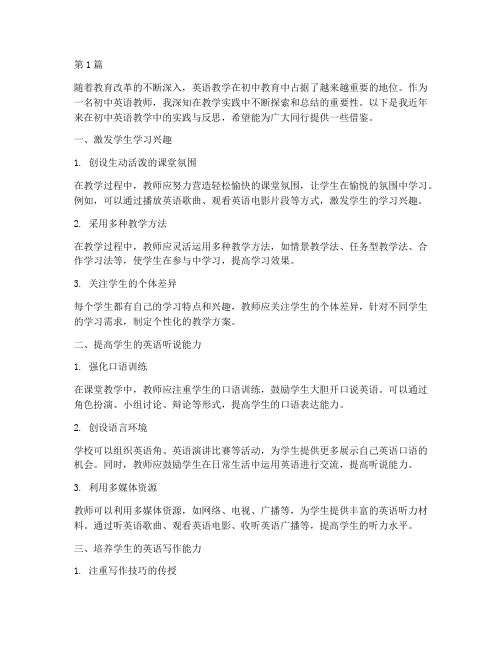
第1篇随着教育改革的不断深入,英语教学在初中教育中占据了越来越重要的地位。
作为一名初中英语教师,我深知在教学实践中不断探索和总结的重要性。
以下是我近年来在初中英语教学中的实践与反思,希望能为广大同行提供一些借鉴。
一、激发学生学习兴趣1. 创设生动活泼的课堂氛围在教学过程中,教师应努力营造轻松愉快的课堂氛围,让学生在愉悦的氛围中学习。
例如,可以通过播放英语歌曲、观看英语电影片段等方式,激发学生的学习兴趣。
2. 采用多种教学方法在教学过程中,教师应灵活运用多种教学方法,如情景教学法、任务型教学法、合作学习法等,使学生在参与中学习,提高学习效果。
3. 关注学生的个体差异每个学生都有自己的学习特点和兴趣,教师应关注学生的个体差异,针对不同学生的学习需求,制定个性化的教学方案。
二、提高学生的英语听说能力1. 强化口语训练在课堂教学中,教师应注重学生的口语训练,鼓励学生大胆开口说英语。
可以通过角色扮演、小组讨论、辩论等形式,提高学生的口语表达能力。
2. 创设语言环境学校可以组织英语角、英语演讲比赛等活动,为学生提供更多展示自己英语口语的机会。
同时,教师应鼓励学生在日常生活中运用英语进行交流,提高听说能力。
3. 利用多媒体资源教师可以利用多媒体资源,如网络、电视、广播等,为学生提供丰富的英语听力材料。
通过听英语歌曲、观看英语电影、收听英语广播等,提高学生的听力水平。
三、培养学生的英语写作能力1. 注重写作技巧的传授在教学过程中,教师应注重写作技巧的传授,如句子结构、段落组织、文章结构等。
通过讲解和示范,让学生掌握写作的基本规律。
2. 创设写作情境教师可以结合教材内容,创设写作情境,让学生在真实的语境中进行写作。
例如,让学生写一篇关于自己家乡的介绍,或写一篇关于环保的文章。
3. 鼓励学生多写多练教师应鼓励学生多写多练,提高写作能力。
可以通过布置写作作业、开展写作比赛等形式,激发学生的写作兴趣。
四、关注学生的情感态度1. 关爱学生,树立自信教师应关心学生的生活和学习,了解学生的心理需求,帮助学生树立自信。
从基础开始,理论与实践并行,让你成为的初一英语教案范文编写者!
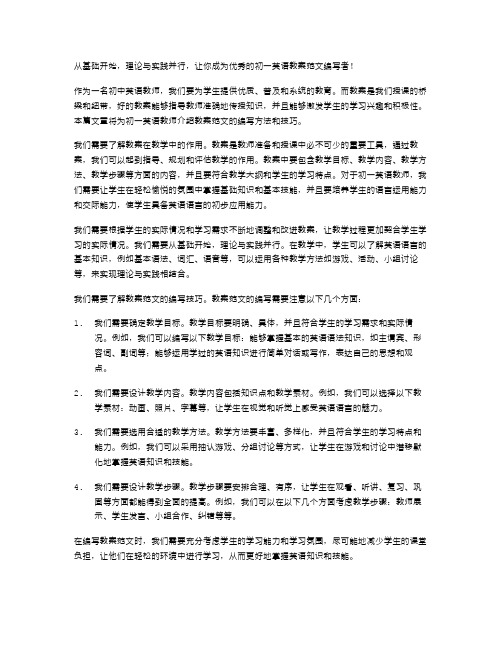
从基础开始,理论与实践并行,让你成为优秀的初一英语教案范文编写者!作为一名初中英语教师,我们要为学生提供优质、普及和系统的教育。
而教案是我们授课的桥梁和纽带,好的教案能够指导教师准确地传授知识,并且能够激发学生的学习兴趣和积极性。
本篇文章将为初一英语教师介绍教案范文的编写方法和技巧。
我们需要了解教案在教学中的作用。
教案是教师准备和授课中必不可少的重要工具,通过教案,我们可以起到指导、规划和评估教学的作用。
教案中要包含教学目标、教学内容、教学方法、教学步骤等方面的内容,并且要符合教学大纲和学生的学习特点。
对于初一英语教师,我们需要让学生在轻松愉悦的氛围中掌握基础知识和基本技能,并且要培养学生的语言运用能力和交际能力,使学生具备英语语言的初步应用能力。
我们需要根据学生的实际情况和学习需求不断地调整和改进教案,让教学过程更加契合学生学习的实际情况。
我们需要从基础开始,理论与实践并行。
在教学中,学生可以了解英语语言的基本知识,例如基本语法、词汇、语音等,可以运用各种教学方法如游戏、活动、小组讨论等,来实现理论与实践相结合。
我们需要了解教案范文的编写技巧。
教案范文的编写需要注意以下几个方面:1.我们需要确定教学目标。
教学目标要明确、具体,并且符合学生的学习需求和实际情况。
例如,我们可以编写以下教学目标:能够掌握基本的英语语法知识,如主谓宾、形容词、副词等;能够运用学过的英语知识进行简单对话或写作,表达自己的思想和观点。
2.我们需要设计教学内容。
教学内容包括知识点和教学素材。
例如,我们可以选择以下教学素材:动画、照片、字幕等,让学生在视觉和听觉上感受英语语言的魅力。
3.我们需要选用合适的教学方法。
教学方法要丰富、多样化,并且符合学生的学习特点和能力。
例如,我们可以采用抽认游戏、分组讨论等方式,让学生在游戏和讨论中潜移默化地掌握英语知识和技能。
4.我们需要设计教学步骤。
教学步骤要安排合理、有序,让学生在观看、听讲、复习、巩固等方面都能得到全面的提高。
英语教学设计理论与实践
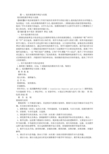
篇一:英语课堂教学理论与实践英语课堂教学理论与实践【摘要】初中英语课堂教学工作的开展旨在培养学生的综合能力,提高他们的语言应用能力。
为实现这一目的,应改善教师的教学方式,提高课堂效率。
二期课改提出的新思想和新理念,提高了学生在课堂中的地位,以学生为主体,使教师的教学方式和学生的学习习惯都发生了很大的改变,实现了课堂效率的最大化。
【关键词】初中英语课堂教学理论实践一、初中英语教学的目的二期课改的新理念主张改变过去以教师讲课为主的传统课堂模式,主张教师的“教”和学生的“学”结合起来,强调学生的主体作用,使学生养成主动学习的好习惯。
培养并提高他们的学习能力,在知识学习的过程中树立正确的价值观、人生观和世界观。
新课改突出将课堂理论与课后实践相结合,通过各种有效的教学方法,使学生能够学以致用,提升他们的专业技能和综合素质。
仁爱版的英语教材不但改变了以前教材中只注重语法的传统,强调了学生视听说的能力,一改“哑巴英语”的弊端,让每个学生都能“开口说话”,提升了学生的英语表达能力,而且对教师的教学提出了更高的要求,要求教师能够创新教学方式,熟练掌握各式多媒体进行教学,并能组织开展各种活动,使枯燥的英语知识具体形象化,提高了学生学习的积极性。
二、初中英语教学中的注意事项1.教师要了解教材。
比如:仁爱版的英语教材共有六册,每册分篇二:英语翻译理论与实践1-教案教师教案课程名称:英文名称:课程编号:总学时:授课班级:使用教材:任课教师:所在单位:32 英语翻译理论与实践 1 translation theories and practice 1 课程类别:专业基础课学分: 2 理论学时: 32 实验学时: 0英汉互译实践与技巧(第三版)职称: 院系(部处)系教务处制教案填写说明教案按每一大节课进行编写,其进度应与授课计划相同。
教案可以是打印稿也可以是手写稿。
有关部分填写要求如下:1、课程类别(封面):包括公共课、学科基础课、专业基础课、专业方向课、实践性教学环节、实验课、专业任选课、公选课。
- 1、下载文档前请自行甄别文档内容的完整性,平台不提供额外的编辑、内容补充、找答案等附加服务。
- 2、"仅部分预览"的文档,不可在线预览部分如存在完整性等问题,可反馈申请退款(可完整预览的文档不适用该条件!)。
- 3、如文档侵犯您的权益,请联系客服反馈,我们会尽快为您处理(人工客服工作时间:9:00-18:30)。
初中英语课堂教学理论与实践【摘要】我们都知道,教学方法的恰当选择是成功进行课程改革保障条件之一,新的国家《英语课程标准》明确指出:提倡任务型教育模式,把综合语言运用能力的培养落实到教学过程中,倡导体验、参与、交流和合作的学习方式,实现任务的目标。
我认为,任务型教学不但是一种教学思想,教学方式,而是一种教学模式;任务性教学法与传统教学法之间差异在于它注意信息沟通任务,活动具有真实性而且活动量大。
英语课堂教学应具有“变化性互动”的各项活动一任务;学生在完成任务过程中进行对话性互动,从而学习语言。
【关键词】变换互动兴趣交流【正文】通过国家组织的国培学习,我受益匪浅,从中学到了以前没有学到过的理论知识,有了新的理论知识做支撑,自己对教学过程的设计有了很大的改进,并对教学过程也有了一定的深刻认识。
下面是我的一点思考:任务型语言教学以学生为主体,教师从学生“学”的角度设计出各种教学活动,使学生的学习具有明确的目标,并构建一个有层次的连续活动,并在完成各种任务的过程中逐步形成运用语言的能力。
其特点在于:(一)极大激发了学生的学习兴趣实施“任务型教学模式”后,初步调整了学生认知结构,学生参与课堂教学的程度提高了,他们不再是学习的“被动客体”,而开始成为学习的“主人”,并由此产生了内在的推动力。
通过多次问卷调查表明学生学习英语的积极性不同程度地调动了起来,极大地激发了学生的学习兴趣,改变了以往“硬着头皮学”“索然无味”的局面,初步实现了“厌学”到“乐学”,从“学会”到“会学”的转变(二)既关注语言本身,也关注学习过程任务型语言课堂把整个教学目标设计成符合本目标的若干个任务,让学生在教师指导下完成各项任务,进而按步骤完成课堂的总体目标。
学生在具体目标下完成任务的过程既是对新知识的理解和运用,又是对旧知识的巩固和掌握,任务完成的好坏就直接体现着教学效果。
(三)以学生为本,促使学生自主发展新的教育理念强调发展学生的主体性,学生只有投身到各种活动中,其主体性才能得到良好的发展。
通过实施任务型教学,使学生在教师的指导下,通过感知,体验,实践,参与和合作等活动方式实现任务的目标,并感受成功,获得自主地发展。
我们所用的初中英语教材,都是围绕学生在日常生活中熟悉并感兴趣的话题,提供了许多真实的语境和语言材料。
因此,我们首先要充分利用好教材,以学生为主体运用任务型教学,培养学生的创造性思维能力,鼓励学生独立思考,合作完成任务。
PWP Pre-learning,While-learning,Post-learning 三个阶段。
Pre-learning (学习前)阶段包括课堂教学之前的一切准备活动,也包括课堂教学中开始学习新的语言内容之前的导入、启动、复习、激活等活动。
While-learning (学习中)阶段是学习新语言的阶段,一般是在课堂进行,但也可以是学习在课堂之外的自我学习活动。
在这一阶段,教师进行知识呈现、讲解,引导学生进行训练,学生通过学习掌握语言内容,形成运用能力。
Post-learning (学习后)阶段是学习新语言之后的评价、运用阶段,这一阶段是课堂之外的运用活动阶段。
PWP 教学过程可以用于英语教学的每一项具体语言教学内容,在技能教学中表现为不同的具体形式,如听力中的 Pre-listening, while-listening 和 post-listening ,口语中的Pre-speaking, while-speaking 和 post-speaking ,阅读中的 Pre-reading,while-reading 和 post-reading ,写作中的 Pre-writing, while-writing 和post-writing 。
作为一名初中英语老师,要具备从事初中英语教学所需要的英语语言能力,掌握外语教学基本理论、英语教学专业知识与国家英语课程标准内容等学科教学知识,并能用以指导初中英语教学。
能够根据英语学科特点,针对初中学生的实际水平和学习需要选择并设计合理的教学内容,形成完整合理的教学方案。
理解初中英语课堂教学实施的基本原则和方法,具备实施语言课堂教学的基本能力;能够根据教学设计,结合教学实际情况,采用恰当的教学手段,引导学生进行有效学习。
了解初中英语课堂教学评价的基本知识和方法,能够对学生的语言学习进行恰当的评价;了解教学反思的基本方法和策略,能够对自己的课堂教学实践进行反思,提出改进的思路。
语言技能是教师最基本的职业技能。
它是教师在教学活动中,运用教与学的有关知识和经验,为促进学生的学习,实现目标而采取的教学行为方式。
它是教师所掌握的理论转向教学实践的中介环节,对于教师提高教学质量、完成教学任务、增强教学能力十分重要。
课堂教学离不开师生之间的交流互动,而这种交流互动是主要、最常用的行为方式就是师生之间的问答。
从教学的实践看,课堂中的问答大致表现为教师提问,学生回答,教师集体致问,师生共同解答,还有就是学生自发地提问。
提问技能是教师提出问题或诱导学生质疑发问引起学生的积极思考、促进学生参与学习、理解和应用知识、了解学生的学习状况的一类教学行为方式。
它是课堂教学中师生相互作用、相互交流的最长用的手段之一。
由此,我联想到平时自己的教学。
同样是在练习的训练中,自己对学生的评价语言就太显单调,“Good”“You are very clever!”等简单、随意的话语经常出现,现在想来,这样的方式对于学生学习积极性的调动的确产生了极大的阻碍。
在一节课中,每个学生回答问题的机会是有限的,他们很在乎老师对他们问题回答的打分。
可老师在一堂课中面临着无数这样的“打分”,容易在意识上产生疲劳,于是,这种简单、随意的评价语言就产生了。
因此在课堂教学中,面对一个个有丰富情感和个性的学生,教师的个性化、灵活化、多样化的评价语言,便是激发学生个体潜能发挥的重要因素。
在新课堂中,我们的评价语言应该充满激励,充满人文关怀。
要及时把握和利用课堂动态生成因素,对学生发表的不同意见,在采取宽容态度的前提下,或者延迟评价,或者恰如其分地进行分析评判,或者顺势引导学生自己发现错误、改正错误。
用恰如其分的表扬、充满关怀的批评、满怀希望的鼓励,帮助学生营造一个愉悦、宽松的学习气氛,就能给学生创造出一个认识自我、建立自信的空间。
另外,教师要关注学生在英语学习上的情感态度,给以多些关爱,成为他们的良师益友,这对课堂教学的有效性起着十分重要的作用。
总之,效益是课堂的永恒追求,初中的英语教学课堂要关注学生的情感,了解学生的兴趣爱好,注意教学的趣味性和多样性,激发不同层次的学生的学习热情,提高全体学生的学习积极性,才能达到最佳的课堂效果。
(四)任务型教学法在英语教学中的实际应用任务型教学模式,让学生在教师的指导下,通过感知、体验、实践参与和合作等形式,逐步达到教学目标规定的要求。
教师要在教学目标的指导下施教,使学生能在任务型教学方式下感受成功,并在学习的过程中获得情感体验和调整学习策略,形成积极的学习态度,促进其语言实际运用能力的提高。
任务型课堂的教学就是把课堂活动任务化,以任务为核心,计划教学步骤,所以“任务“设计的质量是一堂课成败的关键。
设计的任务应具有挑战性,能让学生体验成功。
所以我们必须认真作好学生需要分析,切实了解学生想做什么,会做什么,该做什么,需要设计学以致用的任务,与生活有关的任务,促进学生全面发展的任务。
下面以一课为例说明任务型教学法在英语教学中的应用。
教学八年级上册Unit1Where did you go on vacation? Self Check时,围绕:叙述一次自己的旅行(a good trip)这一主题,我为学生设计了下列任务:1.Describe the place he went to 2.Tell what places he visited 3.Learn about the culture there 4.Talk about if It was a good trip俗话说:行万里路,读万卷书。
旅行不仅可以长见识,也可以体验异地风情,放松心情。
如果学生经常旅游,就能在生活中调节自己的心情更有利于好好学习。
因此,我在该单元教学中设计了上述任务,其目的在于使学生能够运用英语解决真实生活中所存在的问题,从而达到“为用而学、用中学、学中用”的目的。
笔者现将此任务的实施步骤分诉如下:在完成任务一“描述他去的地方”之前,我先让学生在网上查一些这方面的资料,从而为完成这一任务打下基础。
为了更好地完成任务二“讲述自己去过哪些地方”我让学生先弄清如何用英语表达地名,进而完成任务二。
任务三是“通过了旅行了解了哪些当地文化”我让他们 4人一组进行有针对性的讨论。
进而完成任务三。
第四个任务是“谈论旅行的好坏”,就很简单了。
从上面所诉,我们可以看出任务型教学注重真实场景下的,以明确目标为向导的语言交际活动,它要求学生通过完成任务的学习活动来掌握真实、实用和有意义的语言。
它提倡以教师为主导,以学生为主体的教学活动,它倡导体验、实践、参与、交流和合作的学习方式。
学生在参与教师或教材精心设计的任务型学习活动中认识语言,运用语言,发现问题,找出规律,归纳知识和感受成功。
(五)任务型教学在英语教学中的不足,需要进一步发展、完善任务型教学法要求学生运用所学语言完成具体任务、并强调学生的主动参与,它强调交际的过程和语言的功能,注重发展学生的学习策略,因而有利于提高学生的创新精神和语言运用能力。
当然,任务型教学存在一些不完备的地方,比如任务的选择并有进行需求分析,任务的等级评定也是任意的,并且任何形式中心的活动在语言教学中都受到排斥,学生以对子或小组的形式来完成任务,教师在其间不直接指导都有待进一步探讨和研究。
任务型教学法是语言教学的有效途径,同时它是一种新型的教学方式,因此需要在教学中大胆实践,积极探索,使任务型教学模式能够在提高学生的英语实际运用能力上发挥出最大的效应。
参考文献:[1] 肖嫚. 互动式教学模式与英语口语能力培养[J]. 科技信息, 2009,(02) .[2] 高雪松. 英语词汇探索[J]. 科技信息, 2009,(02) . J]. 科技信息, 2009,(02) .[3] 韩炳华. 浅议提高英语口语训练有效性的策略[J]. 扬州教育学院学报, 2007,(01) .[4] 张恩华. 非英语语境下如何快速提高英语口语水平[J]. 职业教育研究, 2006,(11) .育)[5]马琼. 提高英语教学中跨文化交流途径探析[J]. 重庆工贸职业技术学院学报, 2008,(04) .[6]人民共和国教育部主管,华东师范大学主办《中小学英语教学与研究》,《中小学英语教学与研究》编辑部出版,3(2004)[7]教育部基础教育司英语课程标准研制组《英语课程标准解读》. 北京: 师范大学出版社,2002[8]实用中学课堂教学方法大系编委会《中学英语课堂教学方法》. 内蒙古:内蒙古大学出版社,1999[9]胡文仲.《外语教学与文化》. 湖南:湖南教育出版社,2000人民共和国教育部主管,华东师范大学主办《中小学英语教学与研究》,《中小学英语教学与研究》编辑部出版,3(2004)[10]槊. 《启发式教学研究与实践》.北京: 北京师范学院出版社, 1991 13 、张兼中.《外语教育学》.浙江: 浙江教育出版社, 1996。
